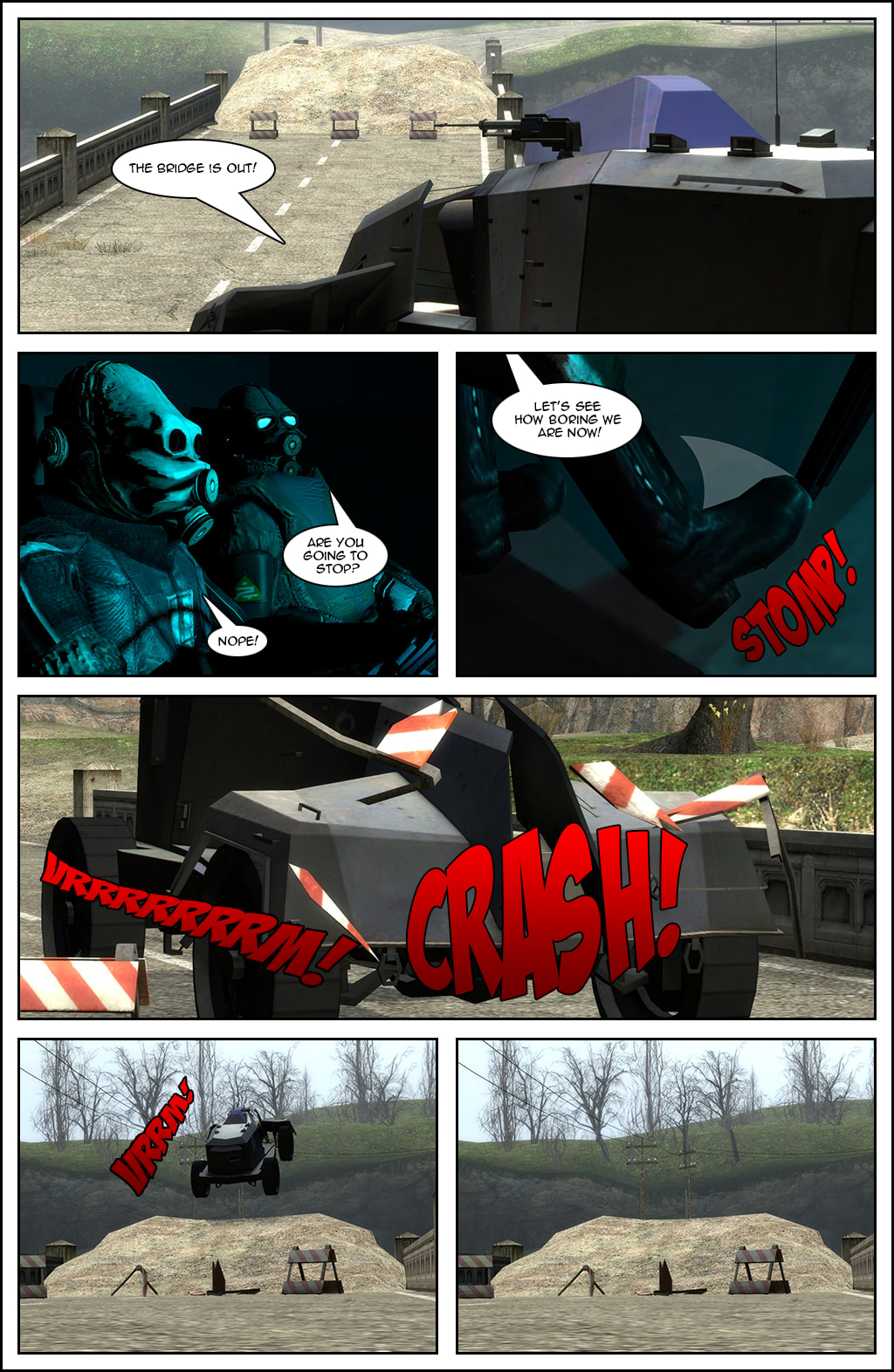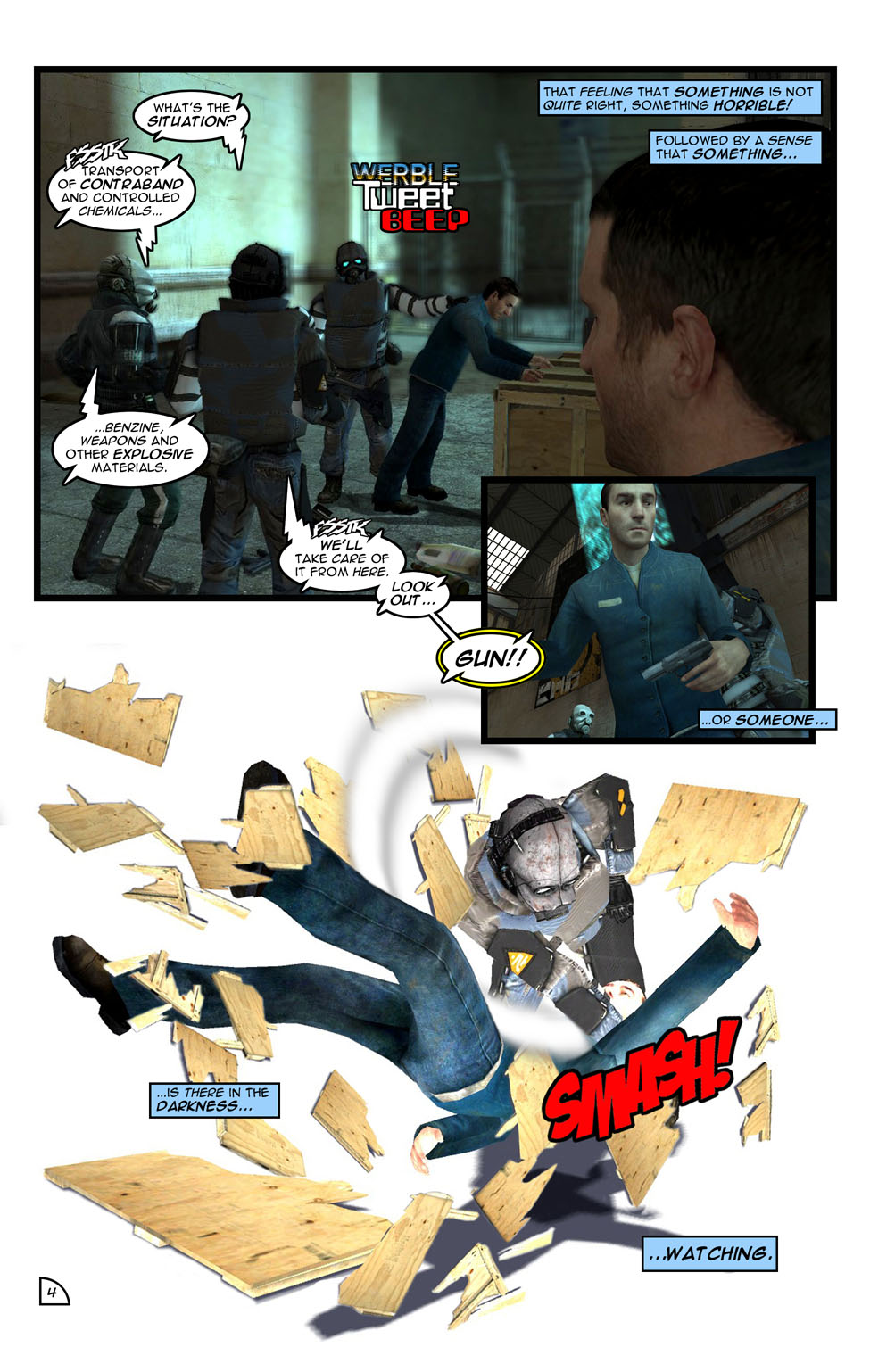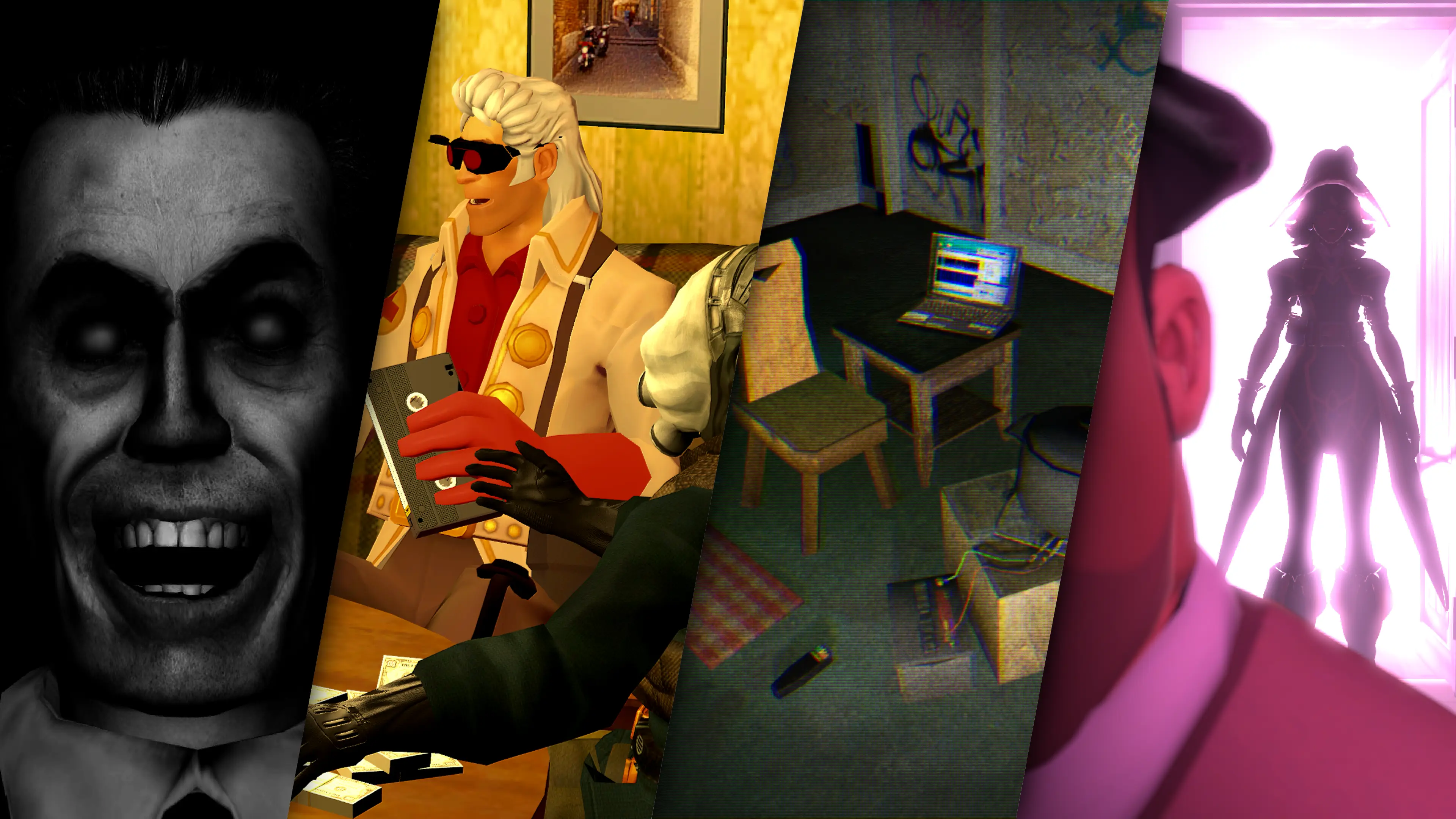You’ve probably seen them before; they’ve been around since 2005, after all. In fact, if you’ve made your way to this website, you are likely familiar with the concept already.
But if you’re not, or just want to learn more about the history of the genre or their pros and cons, here’s absolutely everything you need to know about what Garry’s Mod comics.
What a Garry’s Mod comic is

As the term implies, a Garry’s Mod comic, or GMod comic, is a webcomic created using Garry’s Mod, the Half-Life 2 modification-turned-standalone game that runs on Valve Corporation’s Source engine.
Garry’s Mod comics are made possible by the flexibility of GMod, which allows players to pose “ragdolls” — inactive or “dead” character models, which are manipulable through the game’s Havok physics engine — and props, fly across in-game maps and through walls (“noclipping”) and set in-game cameras to take high-quality screenshots, as well as even do some post-processing within the mod itself. All these tools and features allow players to fairly easily create various shots to serve as panels in a webcomic.
Garry’s Mod comics usually depend not only on Garry’s Mod itself but also some sort of image editing software, Adobe Photoshop and GIMP being arguably the best-known examples, in order to assemble the comics themselves and create additional graphics, such as layouts, borders (known as “gutters”) and speech bubbles.
Advantages and disadvantages of Garry’s Mod comics
While Garry’s Mod comics have mostly been surpassed in popularity by machinima — movies and short films created with game engines, including the Source engine that powers Garry’s Mod —, they still present some overlooked advantages compared to their trendier counterpart.
Advantages
- Garry’s Mod comics, while still requiring dedication and perseverance to make, are easier to make than machinima and require less work-hours;
- Likewise, the barrier of entry to Garry’s Mod comics is much lower than doing machinima;
- Unlike machinima, where dialogue is usually either limited to short in-game voice clips or recorded by amateur/hobbyist voice actors, there is no limitation to writing dialogue in comics;
- By the same logic as the previous point, there is a lot more storytelling potential in comics, meaning that telling long-form stories in multiple parts is not only easier, but also more enjoyable to both make and read;
- Comics as a visual medium have a lot of flexibility for creative design and narrative, allowing creators to stretch their creative muscles and imagination;
- Comics can and do adapt to any genre you’d like, from horror to comedy to drama and so on, meaning you can tell a multitude of stories in this medium and never grow bored;
That said, GMod comics are also not without their own limitations and disadvantages, particularly from being a niche that started off almost two decades ago, with a slower evolution compared to other mediums.
Disadvantages
- Much like machinima isn’t just recording footage, comics are more than taking screenshots. You need to learn and master a lot of soft and hard skills (posing, staging, layouts, image design, typography, etc.) to create good comics;
- Comics are a language all its own, meaning you need to understand the language of comics to be able to really create quality work. Most creators tend to think of comics as basically still pictures from a video when it’s much more complex than that;
- For the same reason as their low barrier of entry, as well as some of their poorer reputation over the years (see the history section below), Garry’s Mod comics have worse public perception than machinima and have had difficulty regaining an audience;
- Whereas machinima have lots of video communities to share (and even monetize) work in, such as YouTube, comics no longer have such a luxury, with Metrocop itself arguably being their current bastion.
In essence, you could think of machinima as similar to silent movies and Garry’s Mod comics as books or, well, comics and graphic novels: the former tell stories mostly through action and physical acting from their characters, whereas the latter are a mix between a novel and still pictures, with all the liberties and drawbacks inherent to that crossover.
A brief history of Garry’s Mod comics
Garry’s Mod comics began life in 2005, shortly after the release of the early versions of Garry’s Mod, then an experimental Half-Life 2 mod that allowed players to use the Physgun, a cut tool from Half-Life 2, to manipulate the in-game physics. Players soon discovered that the tools were perfectly suited to creating the panels of a webcomic, leading to a lot of early comics such as Jeff, Apostasy and, of course, Concerned: The Half-Life and Death of Gordon Frohman.

GMod comics hit the peak of their popularity between 2006 and 2007, when multiple communities were formed around the concept, the two biggest being the Facepunch forums’ own comics section, which would eventually be merged with screenshots and downplayed over the years until the forums’ closure, and PHWOnline, a community dedicated primarily to Garry’s Mod comics, which lasted from 2005 up to 2010.
Garry’s Mod comics ended up also finding their own niche in digital art communities such as DeviantArt, although the proliferation of lesser-quality comics in such communities led to a downgrade in the public perception of GMod comics, which moved away from the standards of quality of the late Facepunch and PHWOnline eras to less emphasis on posing and editing and more crossover with other popular DeviantArt niches, such as the Sonic the Hedgehog fan community.
As the novelty wore off, Garry’s Mod comics would eventually be superceded in popularity by machinima, both in the same Source engine as well as other modern game engines, as well as newer trends like streaming.
It’s worth noting that this very site’s history is intrinsically linked to Garry’s Mod comics, having started as a place to host The Adventures of Hercule Cubbage and a few lost or forgotten comics, which eventually developed into the comics archive we have today.
How to create a Garry’s Mod comic
Sadly, with the aforementioned loss of many of the old Garry’s Mod comic communities over the years, there are not really any high-quality guides on how to create a comic, and while Metrocop doesn’t (yet) have a comprehensive tutorial on comic making either, we can provide you with a few pointers to get started.
Tools you’ll need:
- Garry’s Mod, available to purchase on Steam for the retail price of $9.99;
- Image editing software, such as Adobe Photoshop, which you can get as a paid subscription in a variety of packages, or GIMP, free open source software (MS Paint won’t cut it, I’m afraid).
As basics go, that’s about as basic as you can get. As long as you have Garry’s Mod and decent software to edit raster images, you’re all set to get started. The learning curve isn’t too steep, but naturally you’ll improve the more you practice and intuitively pick up the language of comics.
Suggested GMod add-ons
While Garry’s Mod’s native Physgun tool is good enough to get some decent poses (or even great, once you get some experience with it) and the Faceposer and Camera tools will take care of most basic needs for your first comic, GMod also has a variety of add-ons in its Steam Workshop that you can install to make your life easier and, potentially, your comics better.
Here’s some suggestions to get you started:
- Ragdoll Mover, by Winded: this tool essentially functions similarly to 3D modelling software, allowing you to fine-tune the poses of ragdolls unburdened by the limitations of the physics engine. Also a good stepping stone for an eventual jump to Source Filmmaker;
- Standing Pose Tool, by Winded: while you can learn some in-game tricks to get these poses on your own, Winded’s tool lets you get the radgolls on a “T-pose” — the model’s default pose — to more easily start your posing;
- Animated Prop Tool, by NO LOAFING!: you can — and should — create your own poses from scratch, but sometimes you may need some specific pre-existing pose or even some quick background characters. This handy tool lets you spawn models as, you guessed it, animated props you can control, using the model’s pre-baked animation suite;
- Easy Bonemerge Tool, by Rubat: a bit of a medium-to-advanced user tool, but a useful one nonetheless, Rubat’s tool allows you to link a character’s “bones” — their joints, basically — to a prop’s own “bones”, hence “bonemerge”. This is the same method Valve games use to link weapon and cosmetic props to player models and non-playable characters, for instance, making it more practical than consistently posing said prop in your comic’s models.
You should also get some custom models and maps from the Workshop or the Internet, as the variety of assets in default Garry’s Mod come from Valve’s Half-Life 2, Counter-Strike: Source and Team Fortress 2. You can even use Half-Life: Alyx assets in your creations!
Alternatives to Garry’s Mod for making comics
Garry’s Mod has proven a great tool for creating webcomics because of its flexibility and ease of use, but in the years since it debuted, other tools have come around that serve a similar or even identical purpose.
Possibly the most notable example is Source Filmmaker (abbreviated as SFM), Valve’s own in-house machinima toolset. While it is very much a tool created at first for use by the actual game developers, and therefore has a much steeper learning curve, it also brings a lot of advantages due to its specific focus on creating machinima. More to the point, Source Filmmaker has been updated to be compatible with Valve’s newer Source 2 engine from Half-Life: Alyx, meaning SFM comics are on the cutting-edge of gaming graphics at the moment.
While no other game engine has truly offered the same flexibility as Valve’s Source engine and its successor, you could theoretically also use the popular “photo modes” of most modern games, themselves an evolutionary offshoot of Garry’s Mod and similar platforms, to create comics, although most do not have the same powerful toolset to pose characters and expressions, limiting what you can do.
Now that you know the basics of Garry’s Mod comics, you might be interested in reading some of them! As it happens, Metrocop has an archive with over 600 comics, available to read entirely for free. Feel free to peruse and if you have any questions on how to make a GMod comic or anything related to the subject, leave a comment below and we’ll be sure to help you out. Happy reading!

